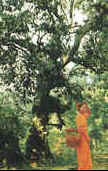About Pu-erh Tea
Pu-erh Special Tea, known as Pu-erh Tea by people outside China, has the features below:
Pu-erh tea is moderate in taste, not as strong as black tea. It can cut grease, help digestion, warm stomach, help produce saliva and slake thirst, dispel the effects of alcohol and refresh one’s mind. Pu-erh tea has functions of lowering the triglyceride, cholesterol, hyperuricemia in the body.
Pu-erh tea is processed through special fermentation by using the semi-made green tea of Yunnan large leaf tea. It is black or brown in colour. The aged Pu-erh tea is mellow and gives a sweet taste in mouth after drinking. It is an ideal health drink for both young and old people.
Pu-erh tea can be kept for a very long time, the longer you keep it the better it tastes and the higher its quality becomes. But it can not be stored air-tight or put in the moisture or close to goods with peculiar smell. It will taste best if brewing with spring water and in a Zisha (purple clay) teapot.
After entering the international market with its unique style, Pu-erh tea is welcomed by customers from different countries. Pu-erh tea has always enjoyed the good reputation of Weight-loss tea, Beauty tea, Slimming tea and Health tea.
History of Pu-erh:
 In ancient times of China, Pu-erh Prefecture (now Pu-erh County) included Xishuangbanna, Simao and Lincang areas of Yunnan, where many famous tea mountains were located. Pu-erh was an important town in southern Yunnan and also the largest market for tea trade. Tea produced in these areas was therefore called “Pu-erh Tea”.
In ancient times of China, Pu-erh Prefecture (now Pu-erh County) included Xishuangbanna, Simao and Lincang areas of Yunnan, where many famous tea mountains were located. Pu-erh was an important town in southern Yunnan and also the largest market for tea trade. Tea produced in these areas was therefore called “Pu-erh Tea”.
According to historical records of China, the ethnic Pu people in Yunnan began to grow tea and served it as tribute to the emperors as early as in the Chinese Shang and Zhou Dynasties (1066 B.C.- 221 B.C.). In the West and East Han Dynasties (206 B.C.- 220 A.D.), tea was grown in river valleys and by the mountains trails of Yizhou. In the Three Kingdoms Period (220 - 280), the Nanzhong tea-seed was widely popularized. In the Tang Dynasty (618 - 907), tea produced in Xishuangbanna was marketed to Dali area and became the favorite drink of the noblemen of the Nanzhao Kingdom. In the Song Dynasty (960 - 1279), Pu-erh County became a famous market for trading tea and horses. In the Yuan Dynasty (1279 - 1368), tea had become the most important commodity in the transactions undertaken by people of all ethnic groups. In the former part of the Qing Dynasty (1644 - 1911), reputation of the Pu-erh tea reached its climax.
In accordance with historical documents on Xishuangbanna, Dai people living there planted tea trees some 1,700 years ago. A tea tree planted 800 years ago is still growing on Mountain Nannuo in Menghai county of Xishuangbanna. In 1961, a large wild tea tree was discovered in the primeval forest on Mountain Dahei of Menghai county. That tea tree is 32.1 m high with a diameter of 1.03 m, and its age is over 1,700 years old. Exuberant and verdant, it still can yield quality tealeaves.
 Most the tea-growing areas here are located at elevations of 2000 meters or so. The annual mean temperature ranges from 12 ºC to 23 ºC, effective annual cumulative temperature is between 4,500ºC and 7,000 ºC, and annual rainfall is 1,000 to 1,900 mm. The monsoon season is concentrated in May through October, during which the rainfall constitutes about 85% of that of the whole year. The monsoon coincides with the hottest months, and there is a very high value of effective rainfall. In the dry season, which starts in November and ends in April, there are sufficient sunny days. There is adequate sunshine, and the tea trees have a long growth period. Under normal conditions, the tealeaf-plucking period may last for 8 to 9 months. The tea-growing areas are generally covered with red, yellow or brick red soils with the pH value ranging between 4 to 6. Comparing with other major tea producing countries, the climate of southern Yunnan is more suitable for growing tea trees.
Most the tea-growing areas here are located at elevations of 2000 meters or so. The annual mean temperature ranges from 12 ºC to 23 ºC, effective annual cumulative temperature is between 4,500ºC and 7,000 ºC, and annual rainfall is 1,000 to 1,900 mm. The monsoon season is concentrated in May through October, during which the rainfall constitutes about 85% of that of the whole year. The monsoon coincides with the hottest months, and there is a very high value of effective rainfall. In the dry season, which starts in November and ends in April, there are sufficient sunny days. There is adequate sunshine, and the tea trees have a long growth period. Under normal conditions, the tealeaf-plucking period may last for 8 to 9 months. The tea-growing areas are generally covered with red, yellow or brick red soils with the pH value ranging between 4 to 6. Comparing with other major tea producing countries, the climate of southern Yunnan is more suitable for growing tea trees.